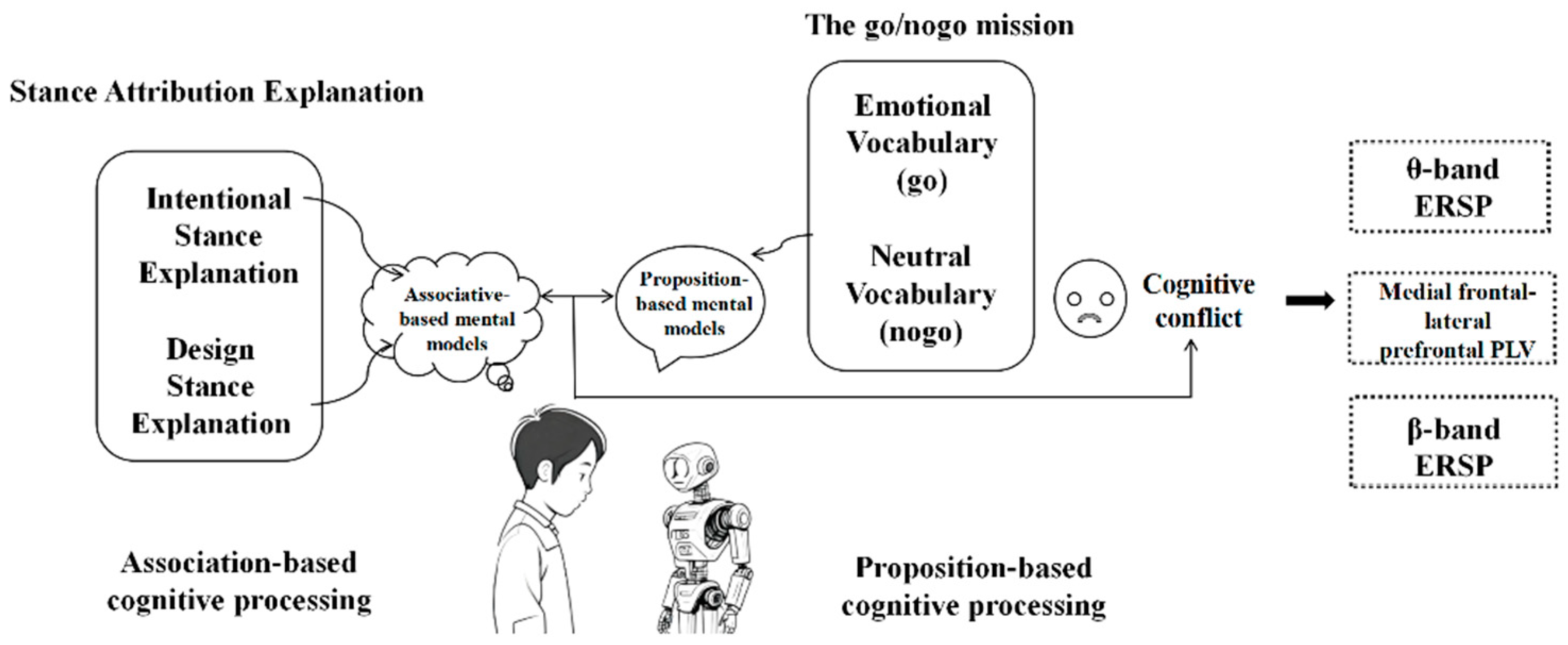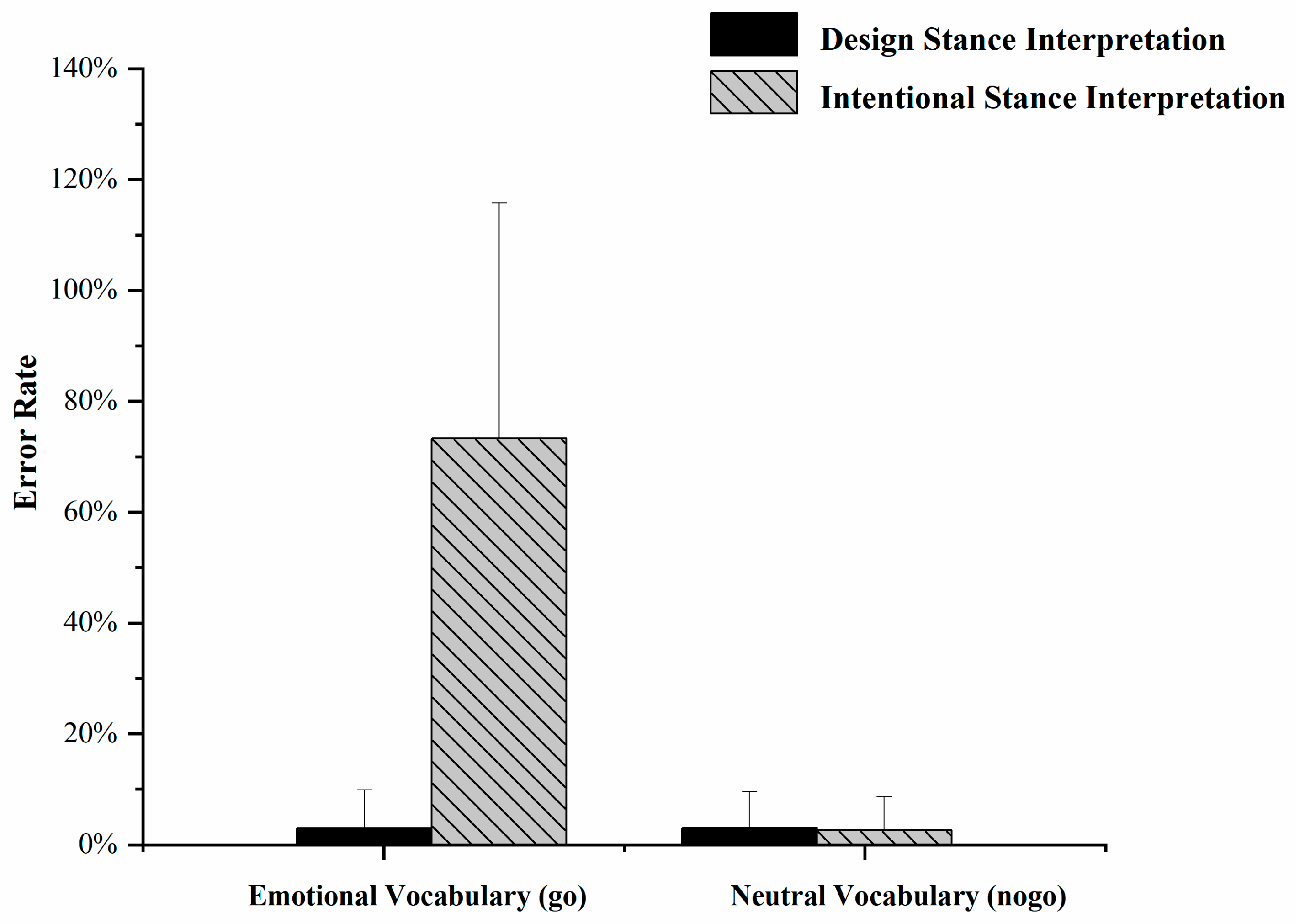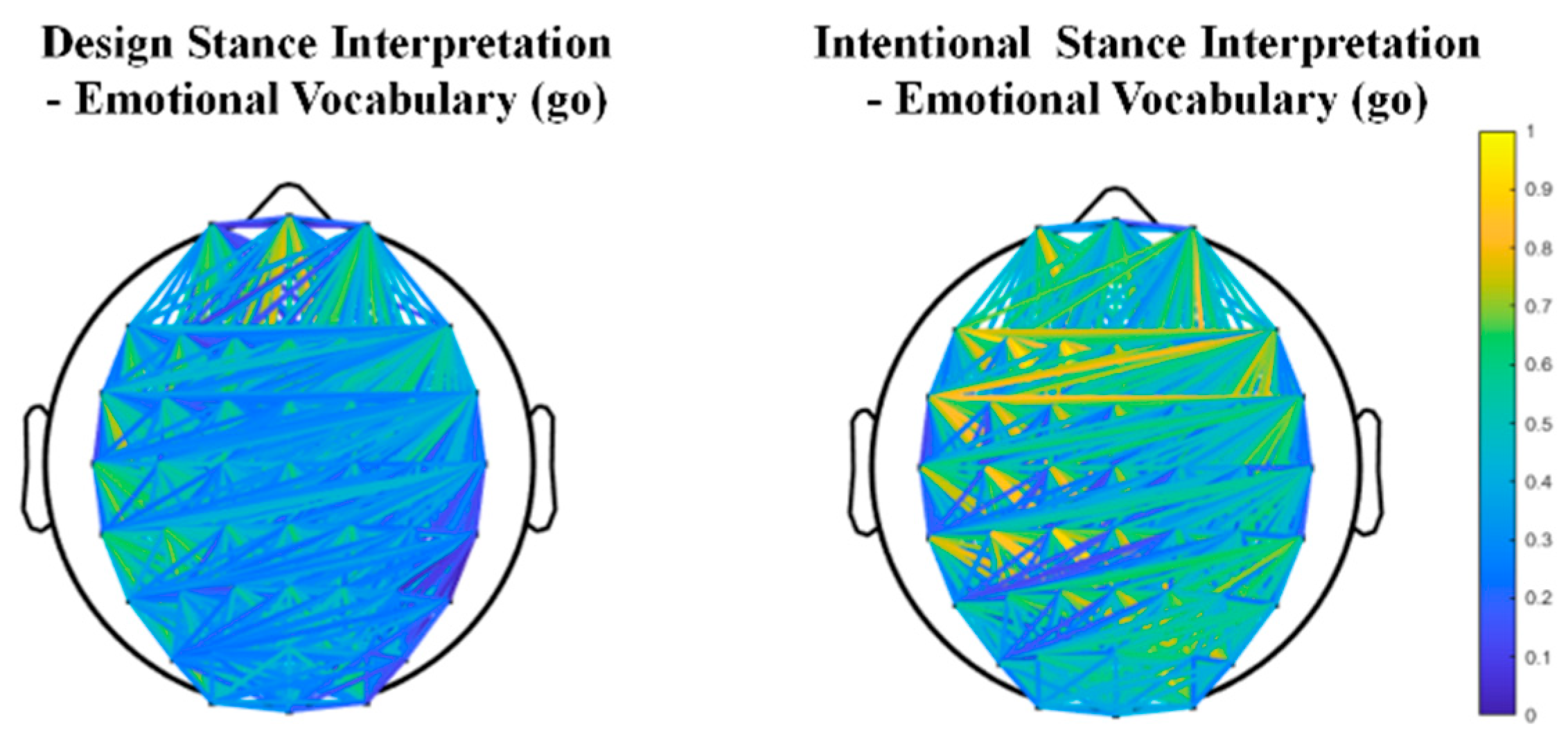Sustainable Impact of Stance Attribution Design Cues for Robots on Human–Robot Relationships—Evidence from the ERSP
Abstract
1. Introduction
2. Literature Review and Research Hypotheses
2.1. Associative–Propositional Evaluation Model
2.2. Mental Models and Design Stance and Intentional Stance
2.3. Research Related to Robotics and Emotion
2.4. Research Related to EEG in Human–Robot Interaction
2.5. Research Hypotheses
3. Methodology
3.1. Participants
3.2. Materials
3.3. Procedures
3.4. Data Acquisition and Analysis
4. Results
4.1. Behavioral Results
4.2. Time Frequency Results
4.3. Functional Connectivity Analysis Results
4.4. Questionnaire Results
5. Discussion
5.1. Theoretical Implication
5.2. Managerial Implication
6. Conclusions and Future Prospects
Author Contributions
Funding
Institutional Review Board Statement
Informed Consent Statement
Data Availability Statement
Conflicts of Interest
Abbreviations
| Acronyms | Full name |
| ERSP | Event-Related Spectral Perturbation |
| PLV | Phase-locking value |
| HRI | Human–robot interaction |
| EEG | Electroencephalography |
| APE | Associative–propositional evaluation |
References
- Foster, M.E.; Gaschler, A.; Giuliani, M.; Isard, A.; Pateraki, M.; Petrick, R.P.A. Two People Walk into a Bar: Dynamic Multi-Party Social Interaction with a Robot Agent. In Proceedings of the 14th ACM International Conference on Multimodal Interaction, Santa Monica, CA, USA, 22–26 October 2012; Association for Computing Machinery: New York, NY, USA, 2012; pp. 3–10. [Google Scholar]
- Hoffman, G.; Zuckerman, O.; Hirschberger, G.; Luria, M.; Shani Sherman, T. Design and Evaluation of a Peripheral Robotic Conversation Companion. In Proceedings of the Tenth Annual ACM/IEEE International Conference on Human-Robot Interaction, Portland, OR, USA, 2–5 March 2015; Association for Computing Machinery: New York, NY, USA, 2015; pp. 3–10. [Google Scholar]
- Bevan, C.; Stanton Fraser, D. Shaking hands and cooperation in tele-present human-robot negotiation. In Proceedings of the Tenth Annual ACM/IEEE International Conference on Human-Robot Interaction, Portland, OR, USA, 2–5 March 2015; Association for Computing Machinery: New York, NY, USA, 2015; pp. 247–254. [Google Scholar]
- Brščić, D.; Kidokoro, H.; Suehiro, Y.; Kanda, T. Escaping from children’s abuse of social robots. In Proceedings of the Tenth Annual ACM/IEEE International Conference on Human-Robot Interaction, Portland, OR, USA, 2–5 March 2015; Association for Computing Machinery: New York, NY, USA, 2015; pp. 59–66. [Google Scholar]
- Breazeal, C. Toward Sociable Robots. Robot. Auton. Syst. 2003, 42, 167–175. [Google Scholar] [CrossRef]
- Kirby, R.; Forlizzi, J.; Simmons, R. Affective Social Robots. Robot. Auton. Syst. 2010, 58, 322–332. [Google Scholar] [CrossRef]
- Fuchs-Frothnhofen, P.; Hartmann, E.A.; Brandt, D.; Weydandt, D. Designing Human-Machine Interfaces to Match the User’s Mental Models. Control Eng. Pract. 1996, 4, 13–18. [Google Scholar] [CrossRef]
- Foster, M.E. Natural Language Generation for Social Robotics: Opportunities and Challenges. Philos. Trans. R. Soc. B Biol. Sci. 2019, 374, 20180027. [Google Scholar] [CrossRef]
- Bossi, F.; Willemse, C.; Cavazza, J.; Marchesi, S.; Murino, V.; Wykowska, A. The Human Brain Reveals Resting State Activity Patterns That Are Predictive of Biases in Attitudes toward Robots. Sci. Robot. 2020, 5, eabb6652. [Google Scholar] [CrossRef] [PubMed]
- Dennett, D.C. Précis of The Intentional Stance. Behav. Brain Sci. 1988, 11, 495–505. [Google Scholar] [CrossRef]
- Ziemke, T. Understanding Social Robots: Attribution of Intentional Agency to Artificial and Biological Bodies. Artif. Life 2023, 29, 351–366. [Google Scholar] [CrossRef]
- Navare, U.P.; Ciardo, F.; Kompatsiari, K.; De Tommaso, D.; Wykowska, A. When Performing Actions with Robots, Attribution of Intentionality Affects the Sense of Joint Agency. Sci. Robot. 2024, 9, eadj3665. [Google Scholar] [CrossRef] [PubMed]
- Li, Z.; Terfurth, L.; Woller, J.P.; Wiese, E. Mind the machines: Applying implicit measures of mind perception to social robotics. In Proceedings of the 2022 17th ACM/IEEE International Conference on Human-Robot Interaction (HRI), Sapporo, Japan, 7–10 March 2022; pp. 236–245. [Google Scholar]
- Gawronski, B.; Bodenhausen, G.V. Associative and Propositional Processes in Evaluation: An Integrative Review of Implicit and Explicit Attitude Change. Psychol. Bull. 2006, 132, 692–731. [Google Scholar] [CrossRef]
- Potesnak, K. Mental Models: Helping Users Understand Software. IEEE Softw. 1989, 6, 85–86. [Google Scholar] [CrossRef]
- van den Broek, K.L.; Luomba, J.; van den Broek, J.; Fischer, H. Evaluating the Application of the Mental Model Mapping Tool (M-Tool). Front. Psychol. 2021, 12, 761882. [Google Scholar] [CrossRef] [PubMed]
- Roselli, C.; Navare, U.P.; Ciardo, F.; Wykowska, A. Type of Education Affects Individuals’ Adoption of Intentional Stance Towards Robots: An EEG Study. Int. J. Soc. Robot. 2024, 16, 185–196. [Google Scholar] [CrossRef]
- McLaren, I.P.L.; Forrest, C.L.D.; McLaren, R.P.; Jones, F.W.; Aitken, M.R.F.; Mackintosh, N.J. Associations and Propositions: The Case for a Dual-Process Account of Learning in Humans. Neurobiol. Learn. Mem. 2014, 108, 185–195. [Google Scholar] [CrossRef]
- Evans, J.S.B.T. Dual-Processing Accounts of Reasoning, Judgment, and Social Cognition. Annu. Rev. Psychol. 2008, 59, 255–278. [Google Scholar] [CrossRef]
- Gawronski, B.; Bodenhausen, G.V. Unraveling the Processes Underlying Evaluation: Attitudes from the Perspective of the Ape Model. Soc. Cogn. 2007, 25, 687–717. [Google Scholar] [CrossRef]
- Naderpour, M.; Lu, J.; Zhang, G. A Human-System Interface Risk Assessment Method Based on Mental Models. Saf. Sci. 2015, 79, 286–297. [Google Scholar] [CrossRef]
- Phillips, E.; Ososky, S.; Grove, J.; Jentsch, F. From Tools to Teammates: Toward the Development of Appropriate Mental Models for Intelligent Robots. Proc. Hum. Factors Ergon. Soc. Annu. Meet. 2011, 55, 1491–1495. [Google Scholar] [CrossRef]
- Storjak, I.; Krzic, A.S.; Jagust, T. Elementary School Pupils’ Mental Models Regarding Robots and Programming. IEEE Trans. Educ. 2022, 65, 297–308. [Google Scholar] [CrossRef]
- Revell, K.M.A.; Stanton, N.A. Mental Model Interface Design: Putting Users in Control of Home Heating. Build. Res. Inf. 2018, 46, 251–271. [Google Scholar] [CrossRef]
- Brennen, J.S.; Lazard, A.J.; Adams, E.T. Multimodal Mental Models: Understanding Users’ Design Expectations for mHealth Apps. Health Inform. J. 2020, 26, 1493–1506. [Google Scholar] [CrossRef]
- Urgen, B.A.; Kutas, M.; Saygin, A.P. Uncanny Valley as a Window into Predictive Processing in the Social Brain. Neuropsychologia 2018, 114, 181–185. [Google Scholar] [CrossRef]
- Papagni, G.; Koeszegi, S. A Pragmatic Approach to the Intentional Stance Semantic, Empirical and Ethical Considerations for the Design of Artificial Agents. Minds Mach. 2021, 31, 505–534. [Google Scholar] [CrossRef]
- Veit, W.; Browning, H. Social Robots and the Intentional Stance. Behav. Brain Sci. 2023, 46, e47. [Google Scholar] [CrossRef]
- Spatola, N.; Marchesi, S.; Wykowska, A. The Intentional Stance Test-2: How to Measure the Tendency to Adopt Intentional Stance Towards Robots. Front. Robot. AI 2021, 8, 666586. [Google Scholar] [CrossRef]
- Kiesler, S.; Powers, A.; Fussell, S.R.; Torrey, C. Anthropomorphic Interactions with a Robot and Robot–like Agent. Soc. Cogn. 2008, 26, 169–181. [Google Scholar] [CrossRef]
- Schellen, E.; Wykowska, A. Intentional Mindset Toward Robots—Open Questions and Methodological Challenges. Front. Robot. AI 2019, 5, 139. [Google Scholar] [CrossRef]
- Abubshait, A.; Wykowska, A. Repetitive Robot Behavior Impacts Perception of Intentionality and Gaze-Related Attentional Orienting. Front. Robot. AI 2020, 7, 565825. [Google Scholar] [CrossRef]
- Picard, R.W. Affective Computing; MIT Press: Cambridge, MA, USA, 2000; ISBN 978-0-262-66115-7. [Google Scholar]
- Spezialetti, M.; Placidi, G.; Rossi, S. Emotion Recognition for Human-Robot Interaction: Recent Advances and Future Perspectives. Front. Robot. AI 2020, 7, 532279. [Google Scholar] [CrossRef]
- Pessoa, L. Do Intelligent Robots Need Emotion? Trends Cogn. Sci. 2017, 21, 817–819. [Google Scholar] [CrossRef]
- Ficocelli, M.; Terao, J.; Nejat, G. Promoting Interactions Between Humans and Robots Using Robotic Emotional Behavior. IEEE Trans. Cybern. 2016, 46, 2911–2923. [Google Scholar] [CrossRef]
- Shao, M.; Snyder, M.; Nejat, G.; Benhabib, B. User Affect Elicitation with a Socially Emotional Robot. Robotics 2020, 9, 44. [Google Scholar] [CrossRef]
- Hieida, C.; Nagai, T. Survey and Perspective on Social Emotions in Robotics. Adv. Robot. 2022, 36, 17–32. [Google Scholar] [CrossRef]
- Becker, M.; Efendić, E.; Odekerken-Schröder, G. Emotional Communication by Service Robots: A Research Agenda. J. Serv. Manag. 2022, 33, 675–687. [Google Scholar] [CrossRef]
- Spekman, M.L.C.; Konijn, E.A.; Hoorn, J.F. How Physical Presence Overrides Emotional (Coping) Effects in HRI: Testing the Transfer of Emotions and Emotional Coping in Interaction with a Humanoid Social Robot. Int. J. Soc. Robot. 2021, 13, 407–428. [Google Scholar] [CrossRef]
- Spatola, N.; Wudarczyk, O.A. Ascribing Emotions to Robots: Explicit and Implicit Attribution of Emotions and Perceived Robot Anthropomorphism. Comput. Hum. Behav. 2021, 124, 106934. [Google Scholar] [CrossRef]
- Ta-Johnson, V.P.; Boatfield, C.; Wang, X.; DeCero, E.; Krupica, I.C.; Rasof, S.D.; Motzer, A.; Pedryc, W.M. Assessing the Topics and Motivating Factors Behind Human-Social Chatbot Interactions: Thematic Analysis of User Experiences. JMIR Hum. Factors 2022, 9, e38876. [Google Scholar] [CrossRef]
- Andreasson, R.; Alenljung, B.; Billing, E.; Lowe, R. Affective Touch in Human–Robot Interaction: Conveying Emotion to the Nao Robot. Int. J. Soc. Robot. 2018, 10, 473–491. [Google Scholar] [CrossRef]
- Zheng, X.; Shiomi, M.; Minato, T.; Ishiguro, H. Modeling the Timing and Duration of Grip Behavior to Express Emotions for a Social Robot. IEEE Robot. Autom. Lett. 2021, 6, 159–166. [Google Scholar] [CrossRef]
- Wei, Q.; Lv, D.; Fu, S.; Zhu, D.; Zheng, M.; Chen, S.; Zhen, S. The Influence of Tourist Attraction Type on Product Price Perception and Neural Mechanism in Tourism Consumption: An ERP Study. Psychol. Res. Behav. Manag. 2023, 16, 3787–3803. [Google Scholar] [CrossRef]
- Lahane, P.; Jagtap, J.; Inamdar, A.; Karne, N.; Dev, R. A Review of Recent Trends in EEG Based Brain-Computer Interface. In Proceedings of the 2019 International Conference on Computational Intelligence in Data Science (ICCIDS), Las Vegas, NV, USA, 5–7 December 2019; pp. 1–6. [Google Scholar]
- Gerjets, P.; Walter, C.; Rosenstiel, W.; Bogdan, M.; Zander, T.O. Cognitive State Monitoring and the Design of Adaptive Instruction in Digital Environments: Lessons Learned from Cognitive Workload Assessment Using a Passive Brain-Computer Interface Approach. Front. Neurosci. 2014, 8, 385. [Google Scholar] [CrossRef]
- Hinz, N.-A.; Ciardo, F.; Wykowska, A. ERP Markers of Action Planning and Outcome Monitoring in Human–Robot Interaction. Acta Psychol. 2021, 212, 103216. [Google Scholar] [CrossRef]
- Saha, S.; Mamun, K.A.; Ahmed, K.; Mostafa, R.; Naik, G.R.; Darvishi, S.; Khandoker, A.H.; Baumert, M. Progress in Brain Computer Interface: Challenges and Opportunities. Front. Syst. Neurosci. 2021, 15, 578875. [Google Scholar] [CrossRef]
- Perez-Osorio, J.; Abubshait, A.; Wykowska, A. Irrelevant Robot Signals in a Categorization Task Induce Cognitive Conflict in Performance, Eye Trajectories, the N2 Component of the EEG Signal, and Frontal Theta Oscillations. J. Cogn. Neurosci. 2021, 34, 108–126. [Google Scholar] [CrossRef]
- Henschel, A.; Hortensius, R.; Cross, E.S. Social Cognition in the Age of Human–Robot Interaction. Trends Neurosci. 2020, 43, 373–384. [Google Scholar] [CrossRef]
- Vecchio, F.; Nucci, L.; Pappalettera, C.; Miraglia, F.; Iacoviello, D.; Rossini, P.M. Time-Frequency Analysis of Brain Activity in Response to Directional and Non-Directional Visual Stimuli: An Event Related Spectral Perturbations (ERSP) Study. J. Neural Eng. 2022, 19, 66004. [Google Scholar] [CrossRef]
- Cavanagh, J.F.; Frank, M.J. Frontal Theta as a Mechanism for Cognitive Control. Trends Cogn. Sci. 2014, 18, 414–421. [Google Scholar] [CrossRef]
- Carter, C.S.; Van Veen, V. Anterior Cingulate Cortex and Conflict Detection: An Update of Theory and Data. Cogn. Affect. Behav. Neurosci. 2007, 7, 367–379. [Google Scholar] [CrossRef]
- Pscherer, C.; Wendiggensen, P.; Mückschel, M.; Bluschke, A.; Beste, C. Alpha and Theta Band Activity Share Information Relevant to Proactive and Reactive Control during Conflict-Modulated Response Inhibition. Hum. Brain Mapp. 2023, 44, 5936–5952. [Google Scholar] [CrossRef]
- Cohen, M.; Cavanagh, J.F. Single-Trial Regression Elucidates the Role of Prefrontal Theta Oscillations in Response Conflict. Front. Psychol. 2011, 2, 30. [Google Scholar] [CrossRef]
- Zavala, B.; Damera, S.; Dong, J.W.; Lungu, C.; Brown, P.; Zaghloul, K.A. Human Subthalamic Nucleus Theta and Beta Oscillations Entrain Neuronal Firing During Sensorimotor Conflict. Cereb. Cortex 2017, 27, 496–508. [Google Scholar] [CrossRef]
- Zavala, B.; Jang, A.; Trotta, M.; Lungu, C.I.; Brown, P.; Zaghloul, K.A. Cognitive Control Involves Theta Power within Trials and Beta Power across Trials in the Prefrontal-Subthalamic Network. Brain 2018, 141, 3361–3376. [Google Scholar] [CrossRef]
- Alegre, M.; Gurtubay, I.G.; Labarga, A.; Iriarte, J.; Valencia, M.; Artieda, J. Frontal and Central Oscillatory Changes Related to Different Aspects of the Motor Process: A Study in Go/No-Go Paradigms. Exp. Brain Res. 2004, 159, 14–22. [Google Scholar] [CrossRef]
- Randall, W.M.; Smith, J.L. Conflict and Inhibition in the Cued-Go/NoGo Task. Clin. Neurophysiol. 2011, 122, 2400–2407. [Google Scholar] [CrossRef]
- Zinchenko, A.; Chen, S.; Zhou, R. Affective Modulation of Executive Control in Early Childhood: Evidence from ERPs and a Go/Nogo Task. Biol. Psychol. 2019, 144, 54–63. [Google Scholar] [CrossRef]
- Pataranutaporn, P.; Liu, R.; Finn, E.; Maes, P. Influencing Human–AI Interaction by Priming Beliefs about AI Can Increase Perceived Trustworthiness, Empathy and Effectiveness. Nat. Mach. Intell. 2023, 5, 1076–1086. [Google Scholar] [CrossRef]
- Horstmann, A.C.; Strathmann, C.; Lambrich, L.; Krämer, N.C. Alexa, what’s inside of you: A qualitative study to explore users’ mental models of intelligent voice assistants. In Proceedings of the 23rd ACM International Conference on Intelligent Virtual Agents, Würzburg, Germany, 19–22 September 2023; Association for Computing Machinery: New York, NY, USA, 2023; pp. 1–10. [Google Scholar]
- Grimes, G.M.; Schuetzler, R.M.; Giboney, J.S. Mental Models and Expectation Violations in Conversational AI Interactions. Decis. Support Syst. 2021, 144, 113515. [Google Scholar] [CrossRef]
- Wang, Q.; Meng, L.; Liu, M.; Wang, Q.; Ma, Q. How Do Social-Based Cues Influence Consumers’ Online Purchase Decisions? An Event-Related Potential Study. Electron. Commer. Res. 2016, 16, 1–26. [Google Scholar] [CrossRef]
- Zhao, X.; He, X.; Zhang, W. A Heavy Heart: The Association between Weight and Emotional Words. Front. Psychol. 2016, 7, 920. [Google Scholar] [CrossRef]
- Shank, D.B.; DeSanti, A. Attributions of Morality and Mind to Artificial Intelligence after Real-World Moral Violations. Comput. Hum. Behav. 2018, 86, 401–411. [Google Scholar] [CrossRef]
- Lee, S.; Park, G.; Chung, J. Artificial Emotions for Charity Collection: A Serial Mediation through Perceived Anthropomorphism and Social Presence. Telemat. Inform. 2023, 82, 102009. [Google Scholar] [CrossRef]
- Liu, Y.; Zhan, X.; Li, W.; Han, H.; Wang, H.; Hou, J.; Yan, G.; Wang, Y. The Trait Anger Affects Conflict Inhibition: A Go/Nogo ERP Study. Front. Hum. Neurosci. 2015, 8, 1076. [Google Scholar] [CrossRef]
- Zhang, Y. The Development of Users’ Mental Models of MedlinePlus in Information Searching. Libr. Inf. Sci. Res. 2013, 35, 159–170. [Google Scholar] [CrossRef]
- Suzuki, Y.; Galli, L.; Ikeda, A.; Itakura, S.; Kitazaki, M. Measuring Empathy for Human and Robot Hand Pain Using Electroencephalography. Sci. Rep. 2015, 5, 15924. [Google Scholar] [CrossRef]
- Spatola, N.; Marchesi, S.; Wykowska, A. Cognitive Load Affects Early Processes Involved in Mentalizing Robot Behaviour. Sci. Rep. 2022, 12, 14924. [Google Scholar] [CrossRef]
- Schraw, G.; Moshman, D. Metacognitive Theories. Educ. Psychol. Rev. 1995, 7, 351–371. [Google Scholar] [CrossRef]
- Bürgler, S.; Hennecke, M. Metacognition and Polyregulation in Daily Self-Control Conflicts. Scand. J. Psychol. 2024, 65, 179–194. [Google Scholar] [CrossRef]






| Measure | Value | Frequency | % |
|---|---|---|---|
| Gender | Male | 12 | 48% |
| Female | 13 | 52% | |
| Age | 18~25 | 23 | 92% |
| 26~30 | 2 | 8% | |
| 31~40 | 0 | 0% | |
| 41~50 | 0 | 0% | |
| 51~60 | 0 | 0% | |
| 60+ | 0 | 0% | |
| Other information | Normal vision or corrected normal vision, right-handed, and no history of mental illness | ||
Disclaimer/Publisher’s Note: The statements, opinions and data contained in all publications are solely those of the individual author(s) and contributor(s) and not of MDPI and/or the editor(s). MDPI and/or the editor(s) disclaim responsibility for any injury to people or property resulting from any ideas, methods, instructions or products referred to in the content. |
© 2024 by the authors. Licensee MDPI, Basel, Switzerland. This article is an open access article distributed under the terms and conditions of the Creative Commons Attribution (CC BY) license (https://creativecommons.org/licenses/by/4.0/).
Share and Cite
Lv, D.; Sun, R.; Zhu, Q.; Zuo, J.; Qin, S. Sustainable Impact of Stance Attribution Design Cues for Robots on Human–Robot Relationships—Evidence from the ERSP. Sustainability 2024, 16, 7252. https://doi.org/10.3390/su16177252
Lv D, Sun R, Zhu Q, Zuo J, Qin S. Sustainable Impact of Stance Attribution Design Cues for Robots on Human–Robot Relationships—Evidence from the ERSP. Sustainability. 2024; 16(17):7252. https://doi.org/10.3390/su16177252
Chicago/Turabian StyleLv, Dong, Rui Sun, Qiuhua Zhu, Jiajia Zuo, and Shukun Qin. 2024. "Sustainable Impact of Stance Attribution Design Cues for Robots on Human–Robot Relationships—Evidence from the ERSP" Sustainability 16, no. 17: 7252. https://doi.org/10.3390/su16177252
APA StyleLv, D., Sun, R., Zhu, Q., Zuo, J., & Qin, S. (2024). Sustainable Impact of Stance Attribution Design Cues for Robots on Human–Robot Relationships—Evidence from the ERSP. Sustainability, 16(17), 7252. https://doi.org/10.3390/su16177252






